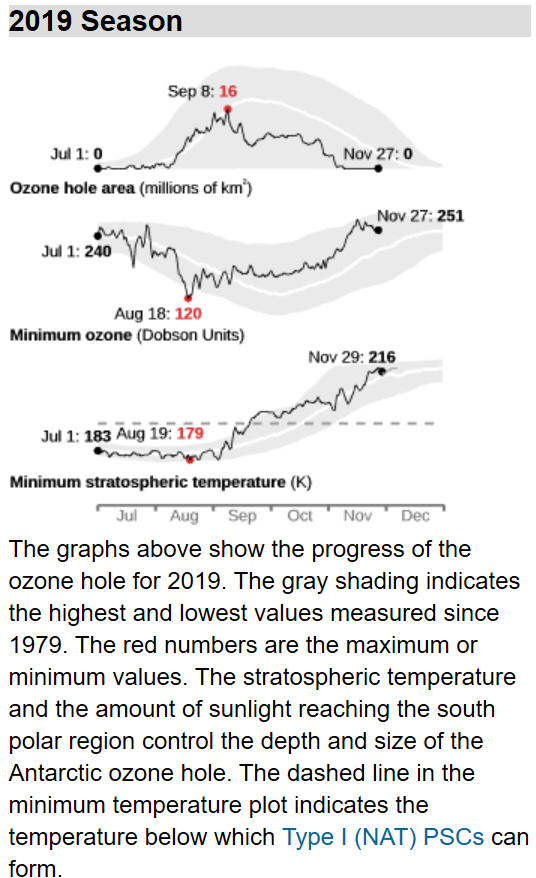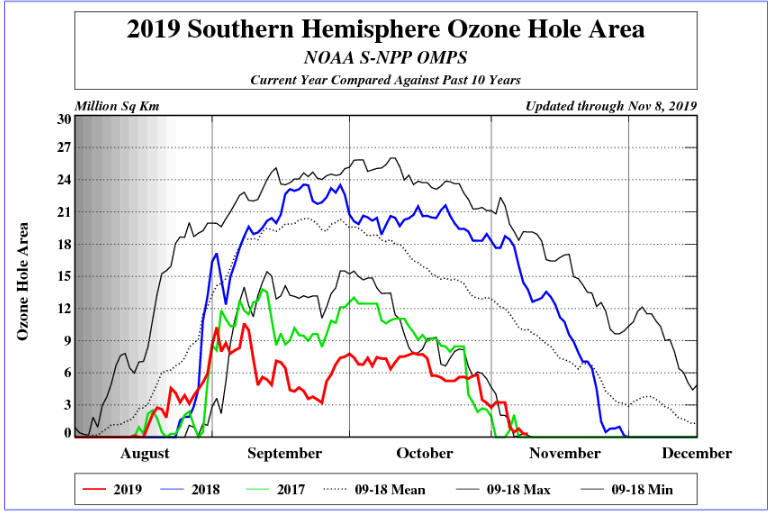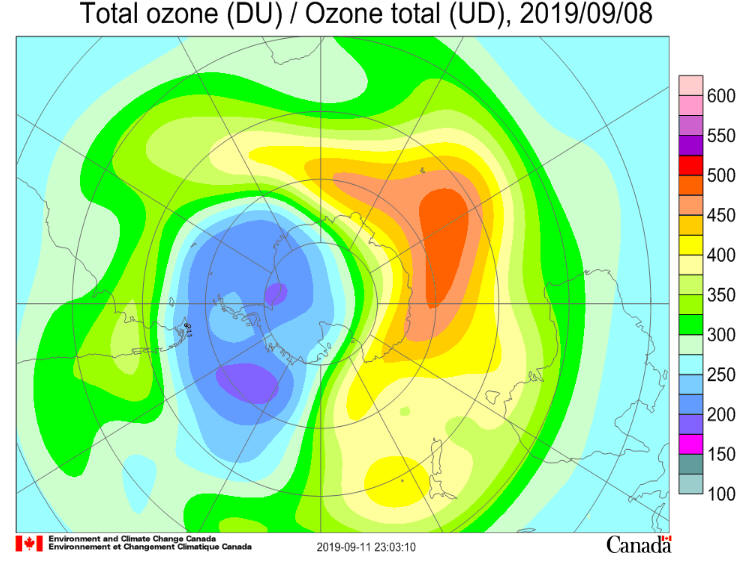|
Oct. 21, 2019
NASA2019
Ozone Hole is the Smallest on Record
Since Its Discovery
Abnormal
weather patterns in the upper atmosphere
over Antarctica dramatically limited
ozone depletion in September and
October, resulting in the smallest ozone
hole observed since 1982, NASA and NOAA
scientists reported today.
The annual ozone hole reached its peak
extent of 6.3 million square miles (16.
4 million square kilometers) on Sept. 8,
and then shrank to less than 3.9 million
square miles (10 million square
kilometers) for the remainder of
September and October, according to NASA
and NOAA satellite measurements. During
years with normal weather conditions,
the ozone hole typically grows to a
maximum area of about 8 million square
miles in late September or early
October.
“It’s great news
for ozone in the Southern Hemisphere,”
said Paul Newman, chief scientist for
Earth Sciences at NASA's Goddard Space
Flight Center in Greenbelt, Maryland.
“But it’s important to recognize that
what we’re seeing this year is due to
warmer stratospheric temperatures. It’s
not a sign that atmospheric ozone is
suddenly on a fast track to recovery.”
Ozone is a highly
reactive molecule comprised of three
oxygen atoms that occurs naturally in
small amounts. Roughly seven to 25 miles
above Earth’s surface, in a layer of the
atmosphere called the stratosphere, the
ozone layer is a sunscreen, shielding
the planet from potentially harmful
ultraviolet radiation that can cause
skin cancer and cataracts, suppress
immune systems and also damage plants.
The Antarctic ozone
hole forms during the Southern
Hemisphere’s late winter as the
returning Sun’s rays start
ozone-depleting reactions. These
reactions involve chemically active
forms of chlorine and bromine derived
from man-made compounds. The chemistry
that leads to their formation involves
chemical reactions that occur on the
surfaces of cloud particles that form in
cold stratospheric layers, leading
ultimately to runaway reactions that
destroy ozone molecules. In warmer
temperatures fewer polar stratospheric
clouds form and they don’t persist as
long, limiting the ozone-depletion
process.
NASA and NOAA
monitor the ozone hole via complementary
instrumental methods.
Satellites,
including NASA’s Aura satellite, the
NASA-NOAA Suomi National Polar-orbiting
Partnership satellite and NOAA’s Joint
Polar Satellite System NOAA-20
satellite, measure ozone from space. The
Aura satellite’s Microwave Limb Sounder
also estimates levels of
ozone-destroying chlorine in the
stratosphere.
At the South Pole,
NOAA staff launch weather balloons
carrying ozone-measuring “sondes” which
directly sample ozone levels vertically
through the atmosphere. Most years, at
least some levels of the stratosphere,
the region of the upper atmosphere where
the largest amounts of ozone are
normally found, are found to be
completely devoid of ozone.
“This year,
ozonesonde measurements at the South
Pole did not show any portions of the
atmosphere where ozone was completely
depleted,” said atmospheric scientist
Bryan Johnson at NOAA’s Earth System
Research Laboratory in Boulder,
Colorado.
Uncommon but not
unprecedented
This is the third
time in the last 40 years that weather
systems have caused warm temperatures
that limit ozone depletion, said Susan
Strahan, an atmospheric scientist with
Universities Space Research Association,
who works at NASA Goddard. Similar
weather patterns in the Antarctic
stratosphere in September 1988 and 2002
also produced atypically small ozone
holes, she said.
“It’s a rare event
that we’re still trying to understand,”
said Strahan. “If the warming hadn’t
happened, we’d likely be looking at a
much more typical ozone hole.”
There is no
identified connection between the
occurrence of these unique patterns and
changes in climate.
The weather systems
that disrupted the 2019 ozone hole are
typically modest in September, but this
year they were unusually strong,
dramatically warming the Antarctic’s
stratosphere during the pivotal time for
ozone destruction. At an altitude of
about 12 miles (20 kilometers),
temperatures during September were 29
degrees F (16˚C) warmer than average,
the warmest in the 40-year historical
record for September by a wide margin.
In addition, these weather systems also
weakened the Antarctic polar vortex,
knocking it off its normal center over
the South Pole and reducing the strong
September jet stream around Antarctica
from a mean speed of 161 miles per hour
to a speed of 67 miles per hour. This
slowing vortex rotation allowed air to
sink in the lower stratosphere where
ozone depletion occurs, where it had two
impacts.
First, the sinking
warmed the Antarctic lower stratosphere,
minimizing the formation and persistence
of the polar stratospheric clouds that
are a main ingredient in the
ozone-destroying process. Second, the
strong weather systems brought
ozone-rich air from higher latitudes
elsewhere in the Southern Hemisphere to
the area above the Antarctic ozone hole.
These two effects led to much higher
than normal ozone levels over Antarctica
compared to ozone hole conditions
usually present since the mid 1980s.
As of October 16,
the ozone hole above Antarctica remained
small but stable and is expected to
gradually dissipate in the coming weeks.
Antarctic ozone
slowly decreased in the 1970s, with
large seasonal ozone deficits appearing
in the early 1980s. Researchers at the
British Antarctic Survey discovered the
ozone hole in 1985, and NASA’s satellite
estimates of total column ozone from the
Total Ozone Mapping Spectrometer
confirmed the 1985 event, revealing the
ozone hole’s continental scale.
Thirty-two years
ago, the international community signed
the Montreal Protocol on Substances that
Deplete the Ozone Layer. This agreement
regulated the consumption and production
of ozone-depleting compounds.
Atmospheric levels of man-made ozone
depleting substances increased up to the
year 2000. Since then, they have slowly
declined but remain high enough to
produce significant ozone loss. The
ozone hole over Antarctica is expected
to gradually become less severe as
chlorofluorocarbons— banned
chlorine-containing synthetic compounds
that were once frequently used as
coolants—continue to decline. Scientists
expect the Antarctic ozone to recover
back to the 1980 level around 2070.
To learn more about
NOAA and NASA efforts to monitor the
ozone and ozone-depleting gases, visit:
https://ozonewatch.gsfc.nasa.gov/
https://www.cpc.ncep.noaa.gov/products/stratosphere/polar/polar.shtml
https://www.esrl.noaa.gov/gmd/dv/spo_oz/
By: Ellen Gray
NASA's Earth
Science News Team
By: Theo Stein
National Oceanic
and Atmospheric Administration
Last Updated: Oct.
22, 2019Editor: Sara Blumberg
|
Five questions about 2019's
record-small ozone hole
How did the 2019 ozone hole compare to previous
years?
In 2019, the hole
that developed in the ozone layer over
Antarctica was the smallest on record since
1982, according to the
NASA/NOAA press release.
In an average spring, the hole expands
throughout September and early October to a
maximum extent of about 8 million square miles
(21 million square kilometers), an area larger
than the United States and Canada combined. In
2019, the hole reached 6.3 million square miles
(16.4 million square kilometers) on September 8,
but then shrank to less than 3.9 million square
miles (10 million square kilometers) for the
remainder of September and the first half of
October.
The ozone hole is
a seasonal thin spot that develops in the ozone
layer, which, over the South Pole, resides at
altitudes from 9-13 miles (14-21 kilometers).
It’s observed with both satellites and with
weather balloons that NOAA scientists launch at
the South Pole. The satellites measure the ozone
hole’s area, and the weather balloons measure
ozone concentrations as they drift up through a
column of the atmosphere. Locations where the
total ozone concentration falls below 220
Dobson units
are considered part of the ozone hole.
In most years since the hole was discovered,
weather balloons rising through the atmospheric
column have passed through regions where ozone
is completely absent from the middle
stratosphere. In 2019, however, they found no
segments of the South Pole profile that were
completely devoid of ozone.
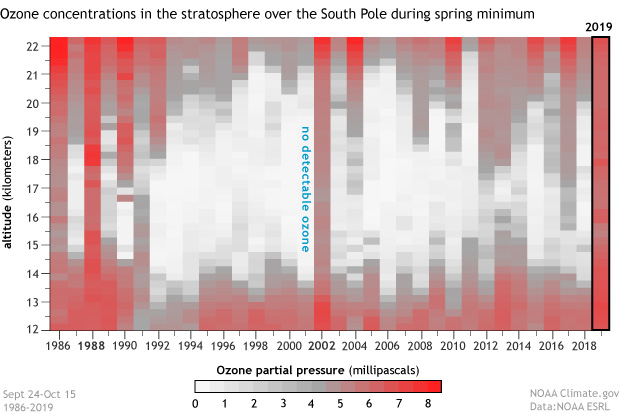
This graph shows ozone concentrations in
a column of the stratosphere (12–22 kilometers)
above the South Pole from the start of the
observational record in 1986 through 2019. Red
areas are parts of the atmospheric column with
high levels of ozone; white and pale gray
show areas where little to no ozone was detected
during annual weather balloon launches. Similar
to 1988 and 2012, the 2019 balloon profiles did
not find any segments of the ozone layer where
ozone was completely depleted. NOAA Climate.gov
image, based on original provided by Bryan
Johnson, NOAA Earth System Research Lab.
Why was the ozone hole so small this year?
An uncommon
weather event—a
sudden stratospheric warming—disrupted
the circulation in the polar stratosphere in
early September, just as the ozone hole was
beginning to form. Warmth in the stratosphere
reduces the formation of polar stratospheric
clouds, which are
a critical link
in the chain of events that lead to the ozone
hole.
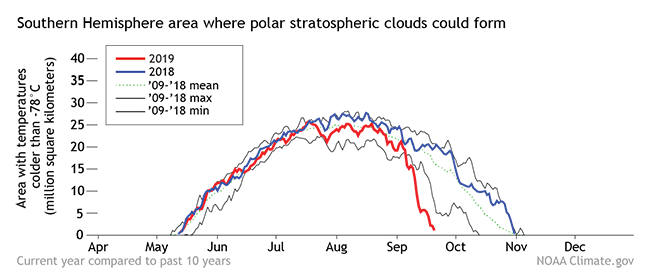
The rapid warm-up came from a breakdown of the
Antarctic polar vortex, a slowly-spinning pool
of stratospheric air trapped by a ring of fierce
westerly winds—the polar night jet—that emerges
in the upper stratosphere during winter at the
South Pole. In an average September, this jet
blows at an average speed of 161 miles per hour,
equivalent to an F3 category tornado or a
Category 5 hurricane. Plunged into darkness and
cut off from warmer latitudes, air in the vortex
can reach temperatures colder than -90 degrees
Celsius.
Every once in a
while, however, the polar night jet is disrupted
by strong
planetary waves
in the atmosphere below. In September 2019, one
of these waves—unusually
strong for
the time of year—jostled the polar stratosphere,
slowing the jet to just 67 miles hour and
knocking the polar vortex off center. When the
jet slows, the air inside the vortex sinks, and
as it sinks, it warms dramatically due to
compression. Beginning in late August 2019,
temperatures
at 10 millibars rose by more than 70 degrees F
(40 degrees Celsius) in just 10 days. September
2019 temperatures at an altitude of about 12
miles (20 kilometers) were 29 degrees F (16˚C)
warmer than average, the warmest in the
historical record by a wide margin.
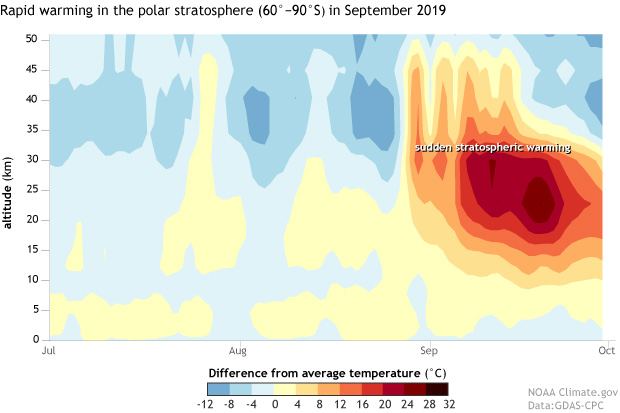
An unusually strong disruption of the Southern
Hemisphere polar vortex in late winter 2019
caused temperatures in the polar stratosphere to
skyrocket. Each column in this image shows the
departure from average temperatures for the
region from 60-90 degrees South latitude at
altitudes between the surface and 50 kilometers.
In late August, temperatures in the stratosphere
spiked (deep red area at image right). NOAA
Climate.gov image, adapted from original
provided by Craig Long, NOAA Climate Prediction
Center.
The breakdown of
the polar vortex helped the ozone hole in two
ways. The early season warmth minimized further
condensation and persistence of polar
stratospheric clouds, which can only form at
temperatures below -78 degrees C.
Because these clouds enable the chemistry that
produces ozone-destroying substances, fewer
clouds meant less ozone destruction.
The breakdown of
the polar vortex also allowed more ozone-rich
air from lower latitudes of the Southern
Hemisphere to mix into the polar stratosphere.
Normally, the polar night jet is an invisible
barrier around the South Pole stratosphere,
preventing air from other parts of the Southern
Hemisphere from mixing in to the vortex. When
the polar vortex
weakened in
early September, an influx of air from lower
latitudes was able to partially patch the hole
that had begun to form. The lingering warmth
prevented it from reforming.
Was the unusual warmth that diminished the 2019
ozone hole the result of global warming?
There is no known
connection between sudden stratospheric warming
events and human-caused global warming. These
events are very rare in the Southern Hemisphere:
this is only the third time in 40 years that one
has been observed in the Antarctic stratosphere.
(They happen more often in the Arctic, where the
polar vortex is generally weaker and polar
temperatures are warmer, which is why the Arctic
doesn’t usually have
an ozone hole.) Conditions similar to this
September’s occurred in September
1988 and
2002. Those
years also produced small ozone holes.
It’s important to
be clear that the South Pole’s sudden
stratospheric warming was a weather event, not a
long-term warming trend. In fact, the same
greenhouse gases that are causing Earth’s
surface and lower atmosphere to warm are
simultaneously causing the stratosphere to cool.
This cooling trend may even slightly
delay the full healing
of the ozone layer.
Does this year's small ozone hole mean recovery
is going faster than we thought?
No, this year’s small ozone hole was simply the
result of an isolated weather event, not part of
a trend. Thanks to the international treaty
banning the production and use of CFCs (short
for chlorofluorocarbons), levels of these
compounds have been declining since about 2000.
But because CFCs are so long-lived,
concentrations remain high enough to cause
significant ozone loss each spring. With
continued declines in CFCs, experts project the
ozone layer will recover to its 1980 conditions
around 2070.
Last year, NOAA scientists
reported on some unexpected violations of
the Montreal Protocol's ban on CFCs. Why didn't
these rogue emissions make this year's ozone
hole worse?
In May 2018, NOAA
scientists reported that starting in 2012, the
global concentration of CFC-11 had stopped
declining. At
a July meeting
of the parties to the Montreal Protocol, members
of the Protocol’s Scientific Assessment Panel
further reported that most likely explanation
for the interrupted trend was new, unreported
emissions. While new production of CFCs is not
compatible with long-term recovery of the ozone
hole, the new emissions will not have an
immediate impact on the ozone hole. That’s
because it takes several years for CFCs for new
CFCs to reach the ozone layer. Atmospheric
scientists say that despite the rogue emissions,
this year’s ozone hole would likely have been
similar to other recent years if not for the
unusual weather conditions.
|
Antarctic ozone
today: The 2019 ozone hole is over and
ozone amounts are high across most of the
continent. Ozone amounts range from around
300 DU to 380 DU. The temperature of the
ozone layer is well above the-78°C
Polar Stratospheric Cloud (PSC) formation
threshold and continues to rise. It
is now generally a little above average values
and is highest over Antarctica and declines
towards the equator. The polar vortex has
dissipated roughly a week earlier than seen in
the last decade.
The 2019 ozone
hole: The 2019
polar vortex began to form in May and had
reached some 20 million square kilometres in
area near the base of the ozone layer by early
July; this was smaller than over the last
decade. At the time of the solstice,
the growing polar vortex was unusually offset
towards the Indian Ocean and centred over East
Antarctica. It returned to being more pole
centred and by early August was some 28 million
square kilometres in area. After the
solstice it was near the smallest over the last
decade and was generally offset towards the
Atlantic. It reached its maximum size in
late August, unusually early and only during
this period was it close to the average size for
the decade. Overall the stratosphere was
quite disturbed during the winter, with strong
wave activity with a period of around a month,
and this gave rise to the smaller than usual
vortex and ozone hole. The vortex
dissipated in late November, roughly a week
earlier than in any year over the previous
decade. Temperatures in the ozone layer
were below the -78°C Polar Stratospheric
Cloud (PSC) formation threshold from late May
until the equinox. A sudden spring warming
of the stratosphere began in early September.
Such an early pulse of warming in the
stratosphere was not uncommon in the years prior
to the formation of an ozone hole in the 1980s,
but it has been rarer in the last 30 years.
More stable conditions returned in October and
during the month the temperature rose more
slowly and by the end of the month was close to
the normal with the spring warming having
subsided. The area with potential PSCs
reached a peak of some 26 million square
kilometres in area at times from mid July to
August and then declined rapidly.
Satellite observations show that the ozone hole
began to grow from mid-August and reached a peak
of around 11 million square kilometres in area
in early September. It then shrank to 3
million square kilometres by the time of the
equinox as a result of the early warming.
More stable conditions returned in late
September and the hole re-grew to a peak size of
some 8 million square kilometres in area in mid
October, still smaller than seen over the last
decade. The final decline came in
early November, slightly later than the ozone
hole of 2017.
Antarctic ozone today:
An annual stratospheric warming commenced unusually
early this year and temperatures are rising through much
of the ozone layer. The area above Antarctica with
Polar Stratospheric Clouds (PSCs) has dropped to near
zero, the smallest at this time of year for decades.
The polar vortex has begun to shrink and is now 23
million square kilometres in area near the base of the
ozone layer; this is smaller than it has been in the
last decade. It is shrinking more rapidly higher
in the ozone layer. The vortex is offset from the
Pole towards the Atlantic. Lowest ozone amounts,
around 190 DU, are over Dronning Maud Land. Ozone
amounts are much higher around Antarctica over the
southern ocean with amounts near 450 DU in places.
The ozone hole is currently some 7 million square
kilometres in area, down from a peak of around 11
million square kilometres in area in early September and
smaller than ever seen in the last decade.
Overall the stratosphere has been much less stable than
usual, which is giving rise to the small size of the
vortex. More stable conditions have returned and
the ozone hole is expected to remain stable over the
coming 10 days, remaining offset from the pole towards
the Atlantic.
Antarctic ozone today:
The annual stratospheric warming has commenced unusually
early this year and temperatures are rising through much
of the ozone layer. The area above Antarctica with
Polar Stratospheric Clouds (PSCs) has dropped to only 1
million square kilometres, the smallest at this time of
year for decades. The polar vortex has begun to
shrink and is now 24 million square kilometres in area
near the base of the ozone layer; this is smaller than
it has been in the last decade. It is shrinking
more rapidly higher in the ozone layer. The vortex
is offset from the Pole towards the Atlantic.
Lowest ozone amounts, around 190 DU, are over West
Antarctica. Ozone amounts are much higher around
Antarctica over the southern ocean with amounts over 440
DU in places. The ozone hole is currently some 5
million square kilometres in area, down from a peak of
around 11 million square kilometres in area in early
September and smaller than ever seen in the last decade.
Overall the stratosphere is much less stable than usual,
which is giving rise to the small size of the vortex.
More stable conditions are returning and ozone depletion
is expected to slightly increase over the coming 10
days, with the hole remaining offset from the pole.
|
Antarctic ozone today:
The 2019 polar vortex began to form in May and has
reached some 32 million square kilometres in area
near the base of the ozone layer; this is smaller
than it has been in the past two years. It is
larger higher up. The growing polar vortex is
offset from the Pole towards the Antarctic
Peninsula. Ozone depletion is increasing, with
lowest amounts below 200 DU over the base of the
Antarctic Peninsula. Ozone amounts are
building over the southern ocean and here
amounts are higher, over 450 DU in places.
Satellite observations show that the 2019 ozone hole
began to grow from mid-August and is currently some
5 million square kilometres in area, fractionally
larger than in the past two years.
Temperatures in the ozone layer are nearing the long
winter minimum and are below the -78°C Polar
Stratospheric Cloud (PSC) formation threshold
through much of the ozone layer, though the highest
part has in places warmed above the threshold.
The area potentially with clouds now covers 21
million square kilometres, close to the average for
the date over the last decade. It is down from
a peak of 26 million square kilometres in mid July.
Overall the stratosphere is much less stable than
usual, which is giving rise to the small size of the
vortex. Stratospheric temperatures are highest
over mid latitudes and decline towards the equator
and the pole. They are generally close to the
average throughout the ozone layer. Ozone
depletion is expected to increase over the Antarctic
Peninsula and Weddell Sea over the coming 10 days.
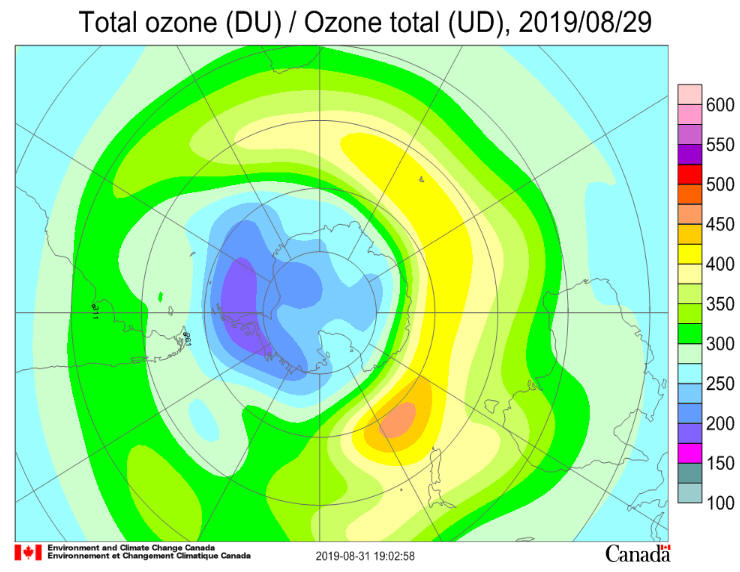
Antarctic ozone
today: The 2019 polar vortex began to form in
May and has reached some 29 million square
kilometres in area near the base of the ozone layer;
this is around the smallest it has been at this date
over the last decade. It is larger higher up.
The growing polar vortex is offset from the Pole
towards the Antarctic Peninsula. Ozone
depletion is increasing, with lowest amounts below
200 DU over the base of the Antarctic Peninsula.
Ozone amounts are building over the southern ocean
and here amounts are higher, over 400 DU in places.
Temperatures in the ozone layer are nearing the long
winter minimum and are below the -78°C Polar
Stratospheric Cloud (PSC) formation threshold
through much of the ozone layer, though the highest
part has in places warmed above the threshold.
The area potentially with clouds now covers 24
million square kilometres, close to the average for
the date over the last decade. It is down from
a peak of 26 million square kilometres in mid July.
Overall the stratosphere is much less stable than
usual, which is giving rise to the small size of the
vortex. Stratospheric temperatures are highest
over mid latitudes and decline towards the equator
and the pole. They are generally close to the
average throughout the ozone layer. Ozone
depletion is expected to increase over West
Antarctica and the Antarctic Peninsula over the
coming 10 days.
|
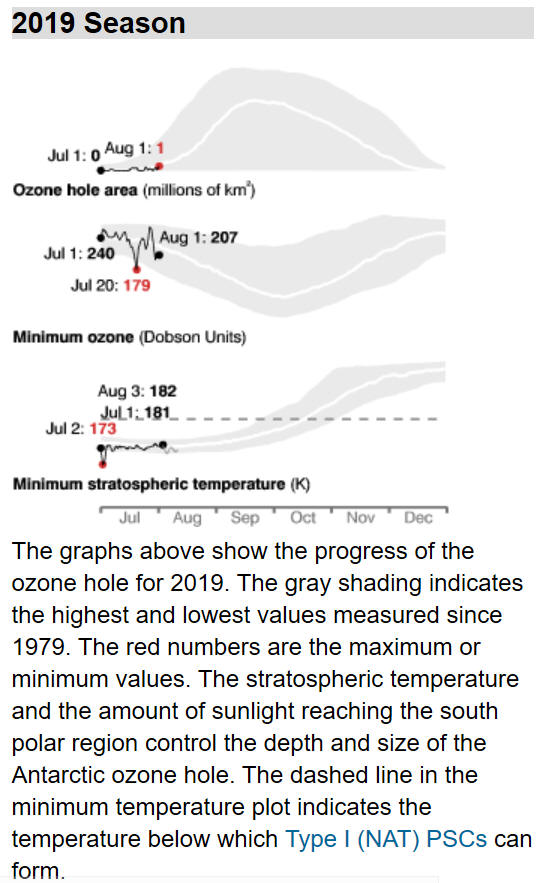
|
Antarctic ozone today:
The 2019 polar vortex began to form in May and has
reached some 25 million square kilometres in area near
the base of the ozone layer, and is larger higher up;
this is smaller than the average over the last decade.
The growing polar vortex is roughly centred on the pole.
Lowest ozone values, around 220 DU, are over the base of
the Antarctic Peninsula. Ozone amounts are
building over the southern ocean and here amounts
are higher, over 400 DU in places. Temperatures in
the ozone layer are nearing the long winter minimum and
have reached the -78°C Polar Stratospheric Cloud
(PSC) formation threshold through much of the ozone
layer. The area potentially with clouds now covers
24 million square kilometres, close to the mean over the
last decade. Stratospheric temperatures are
highest over mid latitudes and decline towards the
equator and the pole. They are generally a little below
average throughout the ozone layer.
|
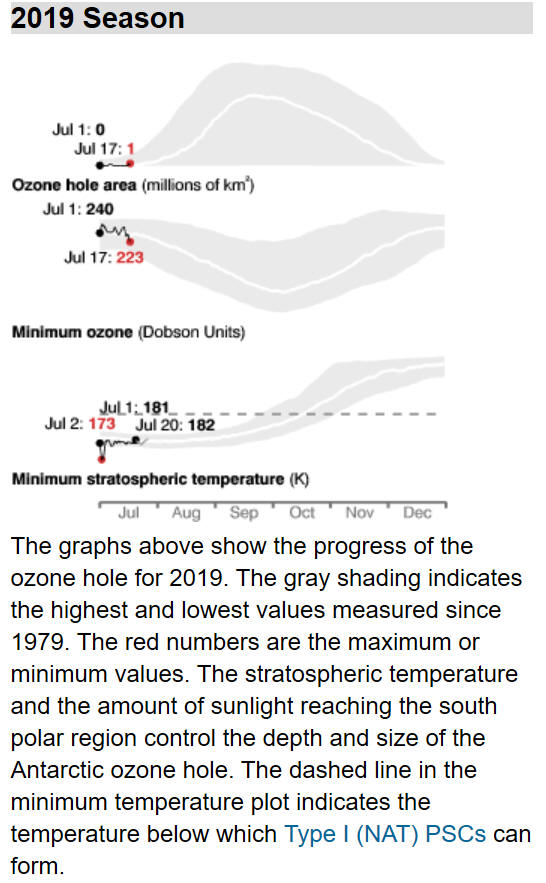 NASA Ozone Watch
NASA Ozone Watch
|
Antarctic ozone today: The 2019 polar vortex began to
form in May and has reached some 20 million square
kilometres in area near the base of the ozone layer, and is
larger higher up; this is smaller than over the last decade.
The temperature throughout the ozone layer is falling
overall. The growing polar vortex has moved back
towards the pole, having been unusually offset towards the
Indian Ocean and centred over East Antarctica at the time of
the solstice. Lowest ozone values, around 210 DU, are
over the base of the Antarctic Peninsula and Rothera
experienced its first day of ozone hole values on July 2.
Ozone amounts are building over the southern ocean and
here amounts are higher, up to 370 DU in places.
Temperatures in the ozone layer are nearing the long winter
minimum and have reached the -78°C Polar Stratospheric
Cloud (PSC) formation threshold through much of the ozone
layer. The area potentially with clouds now covers 22
million square kilometres, close to the mean over the last
decade. Stratospheric temperatures are highest over
mid latitudes and decline towards the equator and the pole.
In the lower stratosphere they are not far from the normal,
though are below the normal in the upper part of the ozone
layer.
|
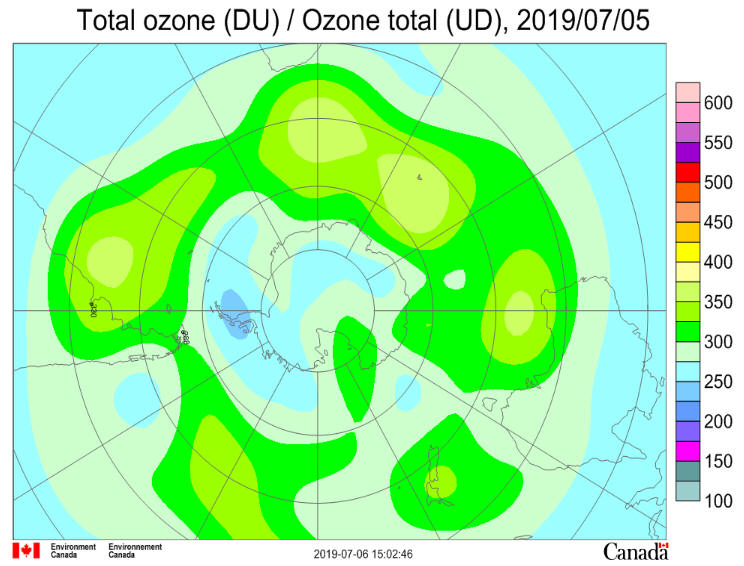
Environment Canada
Ozone Hole July 2019
Ozone Hole August
2019
Ozone Hole September 2019
Ozone Hole October 2019
|
